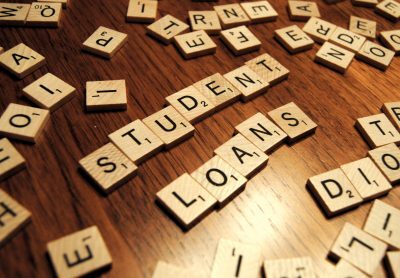Student-centric advice and objective recommendations
Higher education has never been more confusing or expensive. Our goal is to help you navigate the very big decisions related to higher ed with objective information and expert advice. Each piece of content on the site is original, based on extensive research, and reviewed by multiple editors, including a subject matter expert. This ensures that all of our content is up-to-date, useful, accurate, and thorough.
Our reviews and recommendations are based on extensive research, testing, and feedback. We may receive commission from links on our website, but that doesn’t affect our editors’ opinions. Our marketing partners don’t review, approve or endorse our editorial content. It’s accurate to the best of our knowledge when posted. You can find a complete list of our partners here.
Navigating Different Types of Student Loans

 By
Will Geiger
By
Will Geiger 
Will Geiger is the co-founder of Scholarships360 and has a decade of experience in college admissions and financial aid. He is a former Senior Assistant Director of Admissions at Kenyon College where he personally reviewed 10,000 admissions applications and essays. Will also managed the Kenyon College merit scholarship program and served on the financial aid appeals committee. He has also worked as an Associate Director of College Counseling at a high school in New Haven, Connecticut. Will earned his master’s in education from the University of Pennsylvania and received his undergraduate degree in history from Wake Forest University.
Full BioLearn about our editorial policies

Gabriel Jimenez-Ekman is a content editor and writer at Scholarships360. He has managed communications and written content for a diverse array of organizations, including a farmer’s market, a concert venue, a student farm, an environmental NGO, and a PR agency. Gabriel graduated from Kenyon College with a degree in sociology.
Full BioLearn about our editorial policies

Caitlyn Cole is a college access professional with a decade of experience in non-profit program and project management for college readiness and access organizations.
Full BioLearn about our editorial policies

Maria Geiger is Director of Content at Scholarships360. She is a former online educational technology instructor and adjunct writing instructor. In addition to education reform, Maria’s interests include viewpoint diversity, blended/flipped learning, digital communication, and integrating media/web tools into the curriculum to better facilitate student engagement. Maria earned both a B.A. and an M.A. in English Literature from Monmouth University, an M. Ed. in Education from Monmouth University, and a Virtual Online Teaching Certificate (VOLT) from the University of Pennsylvania.
Full BioLearn about our editorial policies

With soaring university prices, it is very common for students to take out debt in order to support their college education. So, if you are among the vast number of students with college loans, you are not alone. However, it’s important to remember that not all types of student loans are the same.
Let’s get into all the different types of student loans and how you should go about making your decisions. First, we’ll go over each type of federal loan. Next, we’ll discuss private student loans. Finally, for those who have already taken out their loans, we’ll discuss the possibility of refinancing. Let’s get into it!
Jump ahead to:
Federal student loans
When it comes time to take out student loans, federal loans should typically be the first place you turn. For the most part, they have the best interest rates, the most flexible repayment plans, and other federal benefits, such as the possibility of deferment and even forgiveness in certain cases. Let’s get into each type of federal loan.
Direct Loans
Also known as Stafford Loans, Federal Direct Loans typically have the lowest interest rates of any loan on the market. You can take out two forms of Federal Direct Loans: Direct Subsidized and Direct Unsubsidized.
Only undergraduate students with demonstrated financial need as determined by successfully completing the FAFSA can qualify for Direct Subsidized Loans. On the other hand, all students who qualify for federal financial aid will qualify for Direct Unsubsidized Loans. You must be enrolled at least half-time to receive Direct Loans.
Direct Subsidized vs. Direct Unsubsidized
| Direct Subsidized | Direct Unsubsidized |
| 4.99% 2022-2023 interest rate for undergraduate students | 4.99% 2022-2023 interest rate for undergraduate students |
| Not available for graduate students | 6.54% 2022-2023 interest rate for graduate students |
| Does not begin to accrue interest until after the borrower has been out of school for their entire six-month grace period | Begins to accrue interest as soon as it is taken out |
| Does not enter repayment until after the borrower has been out of school for their entire six-month grace period | Does not enter repayment until after the borrower has been out of school for their entire six-month grace period |
| Under approved circumstances, borrowers can defer their loan, during which time they make no payments and the loan accrues no interest | Under approved circumstances (such as participating in Americorps or Peace Corps), borrowers can defer their loan, during which time they make no payments, but the loan does accrue interest |
| Students can only qualify if they demonstrate financial need as determined by FAFSA | All students in accredited programs are eligible for these loans |
| Borrowers are limited in how much they can borrow per year | Borrowers are limited in how much they can borrow per year |
| Borrowers can qualify for federal forgiveness through certain programs or in special circumstances | Borrowers can qualify for federal forgiveness through certain programs or in special circumstances |
| Eligible for income-driven and other flexible repayment plans | Eligible for income-driven and other flexible repayment plans |
Takeaways: Federal Direct Loans
- Federal Direct Loans should be the first option you consider when it’s time to take out loans
- They typically have the best interest rates, the best repayment options, and allow borrowers to go back to school and pause payments
- Subsidized Loans are preferable to Unsubsidized Loans, but not everyone can qualify for Subsidized Loans
Since there is a borrowing limit on Direct Loans, many students have to turn to other federal loans and/or private loans. For a detailed table on the amount you can take out per year, check out this page on the Federal Student Aid website.
PLUS Loans
- Parent PLUS Loans, which parents (biological or adoptive) take out to help finance students’ undergraduate education
- Grad PLUS Loans, which graduate students take out to fill any financial need that is not covered by Direct Unsubsidized Loans.
Let’s look at each of them!
Parent PLUS Loans
Parent PLUS Loans allow parents to help pay for the gap between students’ financial aid and the cost of their school. They typically offer better interest rates and more favorable repayment options than private loans. Unlike Direct Loans, they do require a credit check, meaning not all parents will qualify for Parent PLUS Loans. Make sure you have completed the FAFSA before your parent applies for a PLUS Loan!
What if a parent does not qualify?
In the case that a parent does not qualify for a Parent PLUS Loan, their child may be eligible to take out a higher amount of Direct Loans. Make sure to look into this possibility if your parents do not qualify for PLUS Loans!
Grad PLUS Loans
For graduate students whose Direct Unsubsidized Loans do not cover the entirety of their financial need, your next step should be to investigate Grad PLUS Loans. They typically offer lower interest rates and more favorable repayment terms than private loans. Borrowers can utilize any of the same income-driven and flexible repayment plans with Grad PLUS Loans as they can with Direct Loans.
Though they have higher interest rates than Direct Loans, they still typically beat out the market on private loans. They do require a credit check, but do not weigh credit the same way that private lenders do; rather, they only check for specific red flags such as being over 90 days late on any debt, having no defaults or bankruptcies, or other evidence of substantial financial issues.
Direct Consolidation Loans
You cannot take out Direct Consolidation Loans directly; rather, once you already have taken out your federal loans, you have the option of converting them into Direct Consolidation Loans through the process of consolidation. This can simplify your repayment by putting it into the form of one monthly payment, potentially reducing your monthly payments, and might help you qualify for Public Service Loan Forgiveness.
If you have questions about this or think that consolidation might be right for you, talk to your college’s financial aid office or your loan servicer assigned to your loans. Keep in mind – private loans cannot be converted into Direct Consolidation Loans. Only other federal loans are eligible.
FFEL Loans
Federal Family Education Loans (FFEL) are a now-defunct type of loan that has not been offered since 2010. However, for those who have already taken out FFEL Loans, remember that your loans enjoy all the benefits of other federal loans; you have the option of converting them into Direct Consolidation Loans, you can defer them, and you can have them forgiven if you qualify for PSLF or other grounds for federal forgiveness. You can also utilize flexible repayment plans such as income-based repayment.
Perkins Loans
The final Perkins Loans were disbursed in 2018. However, for those, who have already taken out Perkins Loans, keep in mind that your loans enjoy all of the perks of any federal loan; you can qualify for federal loan forgiveness through public service, if you attended a school which has now closed and engaged in malpractice, or under a few other conditions. You can also defer your loans for qualifying reasons, and you can convert your loans to Direct Consolidation Loans. Finally, you can adjust your repayment plans and utilize any federal repayment program.
Private student loans
Typically, students should only turn to private student loans once they have taken out the maximum of Federal loans or if you do not qualify for federal student loans based off of your citizenship status, for example.
Private loans usually come with higher interest rates, and do not offer flexible repayment plans, forgiveness, or deferment options. They also require a credit check, and if you are unable to find a cosigner, they may be difficult to secure.
Finding the best private student loans
Remember, not all private loans are the same! Some are much better than others. Unlike federal loans, they do not have uniform interest rates or repayment terms. You’ll want to do a good amount of shopping around to find an option that offers you a low interest rate and favorable repayment terms. Using a student loan marketplace is the best way to compare a wide variety of loans side-by-side and pick out the best one.
Keep in mind:
- You should always be sure to read over your contract carefully
- Don’t make your decision solely based on the interest rate, but also on the possibility of deferment and the different ways that your repayment might have flexibility
- It’s impossible to know what may happen in the future, and a bit of flexibility in repayment plans could end up benefiting you greatly in the long run.
Considering ISAs
ISAs, or income-share agreements may be a great option for some students. They offer a sense of security that traditional student loans do not.
Rather than signing an agreement to pay back a fixed sum of money to the lender, income-share agreement borrowers sign a contract mandating that upon graduation, they will pay back a fixed percentage of their income for a certain number of years. So, the less they are earning, the less they will pay.
In times of economic uncertainty, this can be an attractive prospect. You’ll only be on the hook for your loans if your degree actually leverages you a high-paying position.
Some colleges offer their own ISA programs to students, and some third-party organizations such as Stride offer agreements to students across a wide range of programs.
However, it’s important to note that these are still only available to a limited number of fields. Typically, students pursuing a degree with a very predictable career outcome and salary will have the possibility of an ISA. The model is not largely available for those studying humanities, social sciences, or other non-STEM fields.
Refinancing student loans
If you’ve already taken out loans and are in the process of repayment, you may consider the option of refinancing student loans. Refinancing student loans can take the form of striking a new agreement with your current lender, or having another lender buy your debt from your current lender and striking up a new repayment agreement with them.
This process can often lower borrowers’ interest rates or change their monthly payments. Here are a few good reasons why you may consider refinancing your student loans.
Good reasons to refinance your student loans
- Change in co-signer – Whether your current co-signer wants to be released from the obligation, or you found a new co-signer who can leverage you better interest rates, this can be a great reason to refinance
- Improvement in credit score – If you took out your loans at a young age and your credit score has since increased significantly, it could be that lenders are now offering you better interest rates. You can refinance your loans to leverage your new score to pay less in interest
- Lowered market interest rates – Student loan interest rates rise and fall with the market. If you took out your loans at a time of higher interest rates, you may want to refinance when the rates drop so as to pay back less in interest
- Lowering monthly payments – Refinancing can extend your overall repayment period, which lowers your monthly payments. If you are having trouble meeting your monthly payments, refinancing can help remedy this problem. However, you should remember that extending your repayment time also allows for more time for interest to accrue, meaning you’ll pay more overall
What to consider before refinancing federal loans
Remember – you can refinance federal or private loans, but whenever you refinance, your loans will become private thereafter. Federal loans come with a host of benefits that private loans do not offer. If you expect that you will have to take advantage of flexible repayment options, if you think you may qualify for loan forgiveness, or if you want to defer your loans in the future, you may not want to refinance your federal loans.
It’s a tough trade-off, as sometimes the lower interest rates of refinanced loans can prove alluring. But before you decide to make the plunge, ensure that you are in a period of financial stability and that the lower interest rates are worth foregoing the option of repayment flexibility.
Further reading: Student loan consolidation vs. refinancing
Final thoughts
Remember, you must pay back all student loans regardless of whether or not you earn a college degree. If you do leave school for any reason, you will still need to pay back all borrowed money. Make sure you do everything possible to earn that degree and increase your earning potential!
Also see: How much student loan debt is too much?
Frequently asked questions about student loans
What are the four types of student loans?
What is the most common type of student loan?





